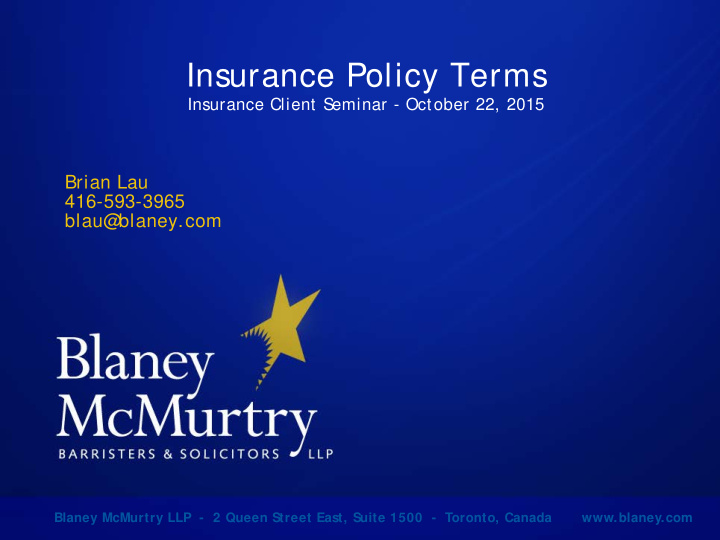



Insurance Policy Terms Insurance Client S eminar - October 22, 2015 Brian Lau 416-593-3965 blau@ blaney.com Blaney McMurtry LLP - 2 Queen Street East, Suite 1500 - Toronto, Canada www.blaney.com
Scenario An insured deliberately sets fire to a property Is there coverage?
Overview 1. Insurance Policy Terms 2. Insuring Agreement 3. Exclusions 4. Exceptions 5. Burden of Proof 6. Conditions 7. Other Terms
What are Policy Terms? Form part of the contract of insurance Can appear on the policy form(s) as listed in the Declarations or through endorsements Dictate the scope of coverage that is available under the policy Also provides for what must occur in order for the insured to receive indemnity for a claim
Insuring Agreement
Insuring Agreement Coverage analysis starts here Defines what types of losses the policy will cover Interpreted broadly If the claim does not fall within the IA, there is no coverage
CGL Insuring Agreement (Coverage A) We will pay those sums that the insured becomes legally obligated to pay as compensatory damages because of bodily injury or property damage to which this insurance applies This insurance applies only to bodily injury and property damage which occurs during the policy period The bodily injury or property damage must be caused by an occurrence
CGL Insuring Agreement Compensatory damages No coverage for punitive or exemplary damages No coverage for declaratory relief Bodily inj ury (BI) or property damage (PD) No coverage for economic loss claims BI or PD must occur during the policy period BI or PD must be caused by an occurrence Occurrence defined as an accident
Property Insuring Agreement All risks of direct physical loss or damage to covered property
Exclusions Insuring Agreement Exclusions
Exclusions Apply to preclude coverage for certain losses that satisfy the Insuring Agreement Only necessary to consider if there is a trigger of coverage Interpreted narrowly
CGL Exclusion Example This insurance does not apply to… property damage to… property you own, rent or occupy Poplawski v. McGrimmon , 2010 ONCA 655 Tense of “ own” implies current ownership The insured no longer owned the property, so the exclusion did not apply Lesson: if relying on an exclusion, ensure that it clearly and unambiguously applies
Property Exclusions Property excluded Automobiles Perils excluded Flood Type of damage excluded Corrosion
Exceptions Insuring Agreement Exclusions Exceptions
Exceptions An exception will apply to limit the scope of a certain exclusion In other words, an exception can bring back coverage for a loss that is excluded Only applies to the exclusion that it appears under Does not extend the coverage provided by the policy’s Insuring Agreement Interpreted broadly
CGL Exception Example This insurance does not apply to… property damage to your work arising out of it or any part of it and included in the products-completed operations hazard. This exclusion does not apply if the damaged work or the work out of which the damage arises was performed on your behalf by a subcontractor.
Property Exception Example This policy does not insure… corrosion… unless caused by a peril not otherwise excluded
Procedure for Coverage Analysis Insuring Agreement – Interpreted broadly Burden on insured Exclusions – Interpreted narrowly Burden on insurer Exceptions – Interpreted broadly Burden on insured
Policy Conditions Things that must happen before the insured can receive indemnity for a loss Notification, cooperation conditions in CGL and property policies Property policies commonly have what are known as statutory conditions Breach of a condition by an insured does not necessarily mean that the insurer can deny indemnity for the claim May be subj ect to relief from forfeiture
Other Policy Terms CGL – Who is an Insured Named Insured, Additional Insured Property – Co-insurance
Procedure for Coverage Analysis 1. Insuring Agreement 2. Exclusions 3. Exceptions 4. Breach of condition Also consider whether there are other applicable terms that may affect the scope of coverage Consider whether there are alternative grounds to preclude or limit coverage
Back to the Scenario
Back to the Scenario Deliberate destructive actions do not trigger the Insuring Agreements of CGL or property policies Exclusions can be relied on in the alternative Also consider breach of conditions
Potential Issues with Exclusions Exclusions are int erpret ed narrowly Criminal Act exclusion may apply May depend on whet her criminal charges are brought against t he insured May also depend on whet her t here is a criminal convict ion Int ent ional act exclusion may apply S ome int ent ional act exclusions only apply if t he loss or damage is int ended by t he insured Did t he insured int end for all of t he damage t o have occurred? What if t he int ent ion was t o burn only a small port ion of t he propert y?
Conclusions When assessing coverage, consider all policy terms Don’ t automatically j ump to exclusions Consider alternate grounds of denial/ reservation of rights to increase likelihood that it will be upheld by a court
QUES TIONS ?
Recommend
More recommend